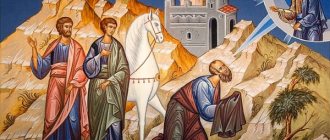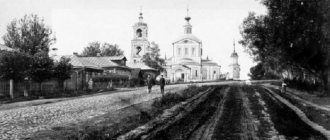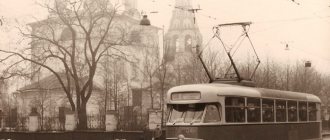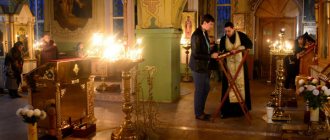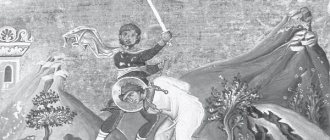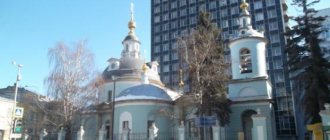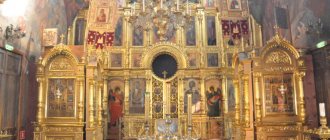Mir
Russia Moscow Temple of the Apostles Peter and Paul at the Yauz Gate (Moscow) Map is loading...
{"format":"leaflet","minzoom":false,"maxzoom":false,"limit":50,"offset":0,"link":"all","sort":[""], "order":[],"headers":"show","mainlabel":"","intro":"","outro":"","searchlabel":"\u2026 \u0441\u043b\u0435\ u0434\u0443\u044e\u0449\u0438\u0435 \u0440\u0435\u0437\u0443\u043b\u044c\u0442\u0430\u0442\u044b","default":"","import-annotation":false,"width ":"auto","height":"350px","centre":{"text":"","title":"""link":"","lat":55.7511099999999970577846397645771503448486328125,"lon": 37.64332999999999884721546550281345844268798828125,"icon":""},"title":"","label":"","icon":"","lines":[],"polygons":[],"circles":[ ],"rectangles":[],"copycoords":false,"static":false,"zoom":8,"defzoom":14,"layers":["OpenStreetMap"],"image layers":[] ,"overlays":[],"resizable":false,"fullscreen":true,"scrollwheelzoom":true,"cluster":false,"clustermaxzoom":9,"clusterzoomonclick":true,"clustermaxradius":80, "clusterspiderfy":true,"geojson":"","clicktarget":"","showtitle":true,"hidenamespace":false,"template":"","userparam":"","activeicon": "","pagelabel":false,"ajaxcoordproperty":"","ajaxquery":"","locations":[{"text":"\u003Cb\u003E\u003Ca href=\"/palomnik/%D0% A5%D1%80%D0%B0%D0%BC_%D0%B0%D0%BF%D0%BE%D1%81%D1%82%D0%BE%D0%BB%D0%BE%D0%B2_% D0%9F%D0%B5%D1%82%D1%80%D0%B0_%D0%B8_%D0%9F%D0%B0%D0%B2%D0%BB%D0%B0_%D1%83_%D0% AF%D1%83%D0%B7%D1%81%D0%BA%D0%B8%D1%85_%D0%B2%D0%BE%D1%80%D0%BE%D1%82_(%D0%9C %D0%BE%D1%81%D0%BA%D0%B2%D0%B0)\» title=\»\u0425\u0440\u0430\u043c \u0430\u043f\u043e\u0441\u0442\u043e\u043b\ u043e\u0432 \u041f\u0435\u0442\u0440\u0430 \u0438 \u041f\u0430\u0432\u043b\u0430 \u0443 \u042f\u0443\u0437\u0441\u043a\u0438 \u0445 \u0432\u043e\u0440\u043e\ u0442 (\u041c\u043e\u0441\u043a\u0432\u0430)\»\u003E\u0425\u0440\u0430\u043c \u0430\u043f\u043e\u0441\u0442\u043e\u043b\u043e \u0432 \u041f\u0435\ u0442\u0440\u0430 \u0438 \u041f\u0430\u0432\u043b\u0430 \u0443 \u042f\u0443\u0437\u0441\u043a\u0438\u0445 \u0432\u043e\u0440 \u043e\u0442 (\u041c\u043e\u0441 \u043a\u0432\u0430)\u003C/a\u003E\u003C/b\u003E\u003Chr /\u003E\u003Ca href=\"/palomnik/%D0%A1%D0%B2%D0%BE%D0%B9% D1%81%D1%82%D0%B2%D0%BE:%D0%90%D0%BD%D0%BD%D0%BE%D1%82%D0%B0%D1%86%D0%B8%D1 %8F\" title=\"\u0421\u0432\u043e\u0439\u0441\u0442\u0432\u043e:\u0410\u043d\u043d\u043e\u0442\u0430\u0446\u0438\u044f\"\u003E\u04 10\ u043d\u043d\u043e\u0442\u0430\u0446\u0438\u044f\u003C/a\u003E: "'\u0425\u0440\u0430\u043c \u0441\u0432\u044f\u0442\u044b\u04 45\u0430\u043f\u043e \u0441\u0442\u043e\u043b\u043e\u0432 \u041f\u0435\u0442\u0440\u0430 \u0438 \u041f\u0430\u0432\u043b\u0430 \u0443 \u042f\u04 43\u0437\u0441\u043a\u0438\u0445 \u0432\u043e\u0440\u043e\u0442"' (\u043d\u0430 \u041a\u0443\u043b\u0438\u0448\u043a\u0430\u0445) \u2014 \u043f\u0440\u0430\u 0432\u043e\u0441\u043b \u0430\u0432\u043d\u044b\u0439 \u0445\u0440\u0430\u043c \u041f\u043e\u043a\u0440\u043e\u0432\u0441\u043a\u043e\u0433\u043e \u0431\u043b\u0430\u0433\u043e \u0447\u0438\u043d\u0438\u044f \u041c\u043e\u0441\u043a\u043e\u0432\u0441\u043a\u043e\u0439 \u0433\u043e\u0440\u043e\u0434\ u0441\u043a\u043e\u0439\u0435 \u043f\u0430\u0440\u0445\u0438\u0438. \u041f\u043e\u0434\u0432\u043e\u0440\u044c\u0435 \u041f\u0430\u0442\u0440\u0438\u0430\u0440\u0445\u0430 \u041c\u043e\u0441\ u043a\u043e\u0432\u0441\u043a \u043e\u0433\u043e \u0438 \u0412\u0441\u0435\u044f \u0420\u0443\u0441\u0438; \u041f\u043e\u0434\u0432\u043e\u0440\u044c\u0435 \u0421\u0435\u0440\u0431\u0441\u043a\u043e\u0439 \u041f\u0440\u0430\u0432\ u043e\u0441\u043b\u0430\u0432 \u043d\u043e\u0439 \u0426\u0435\u0440\u043a\u0432\u0438.","title":"\u0425\u0440\u0430\u043c \u0430\u043f\u043e\u0441\u0442\u043e \u043b\u043e \u0432 \u041f\u0435\u0442\u0440\u0430 \u0438 \u041f\u0430\u0432\u043b\u0430 \u0443 \u042f\u0443\u0437\u0441\u043a\u0438\u04 45\u0432\u043e\u0440\u043e\u0442 (\u041c\u043e\u0441\u043a\u0432\u0430)","link":"","lat":55.7511099999999970577846397645771503448486328125,"lon":37.643329999999998847 21546550281345844268798828125,"icon":""}],,"imageLayers":[] }
55.751052; 37.643138
Russia, Moscow, Petropavlovsky lane, 4-6с3
Moscow
Russia
Telephone:
(495) 917 29 75,, 916-06-27, (495) 917 80 36
Church of the Holy Apostles Peter and Paul at the Yauza Gate
(on Kulishki) - Orthodox church of the Intercession Deanery of the Moscow City Diocese. Metochion of the Patriarch of Moscow and All Rus'; Metochion of the Serbian Orthodox Church.
History[edit]
The temple on this site has been there since ancient times and had the name “Peter and Paul Tall, on the Hill.” The first stone church was commemorated in 1631. Evidence has been preserved that His Holiness Patriarch of Moscow and All Rus' Adrian in March 1693 held a funeral service for Vassa Stroganov in the church. With the blessing of His Holiness, a house church in the name of the Kazan Icon of the Mother of God was built in the parish of the Peter and Paul Church, built in 1698 at the house of General Fyodor Golovin (“stone with ringing”).
1882
With the blessing of His Holiness the Patriarch, the old stone church was dismantled and a new one was built in 1700-1702, which still stands to this day. The main altar of the new church was consecrated in honor of the icon of the Mother of God “The Sign”, and for the old altar in the name of St. ap. Peter and Paul on the north side arranged a special warm winter limit. The patrons and temple builders of the new church were old parishioners from the Eropkin and Kolychev families. The main expenses were covered by Vasilisa Eropkina. The issuance of the antimension to the newly built church took place on January 1, 1702. The architectural style of the new temple belongs to the “Moscow Baroque”.
In 1731, a special Kazan border was built in the church on the southern side and the temple became three-altar. The throne was consecrated on October 13, 1731 by the archpriest of the Great Assumption Cathedral, Ioann Maximov. The temple was badly damaged by the Moscow fire of 1748, but was quickly restored with the help of parishioners. A significant event in the Peter and Paul Parish was the construction in 1771 of a new three-tier bell tower, which took a long time to construct due to the plague epidemic and strict quarantine. From the entry of Apoleon's hordes into Moscow, looting and fires in 1812, the temple itself suffered less than the nearest churches, and after consecration two parish churches were temporarily assigned to it (St. Nicholas in Podkopayi and the Three Saints in Kulishki). The church buildings and the clergy's own houses were all burned. There were never apartment buildings near the church, but clergy lived in church buildings on church land. Of the currently existing buildings, in chronological order, the following were built: in 1830 - a stone 2-story priest's house with mezzanines. Rebuilt in 1888 according to the design of V.N. Korneev; in 1853 according to the design of the architect N.N. Elagin built a 2-story stone deacon's house; in 1879, according to the design of the architect S. Sonin, a 2-story building was built - the house of the sexton and prosphyr.
After the revolution, a real threat of closure hung over the temple, because... this was demanded by the local detachment of pioneers, calling for the transfer of the temple building to their needs. Despite many resolutions of Soviet authorities, by the grace of God the temple was not closed. There was no renovationist schism in the church either. On Easter 1946, immediately after the end of the night liturgy, the long-time rector of the church, Archpriest Arkady Ponomarev, beloved by the parishioners, quietly died in the altar. In 1948, with the blessing of His Holiness Patriarch Alexy I of Moscow and All Rus', a courtyard of the Serbian Orthodox Church was opened at the temple, which actually did not begin to operate for political reasons. By decree of His Holiness Patriach of Moscow and All Rus' Alexy II of December 31, 1999, the Church of St. ap. Peter and Paul was transformed into the Patriarchal Metochion, at which the representation of the Serbian Orthodox Church was resumed.
Petropavlovsky on Vernadsky Avenue
Address: ave. Vernadsky, 76, Moscow
This area of the capital, formed in the 1940s, was included in the so-called “Program 200” for the construction of churches in those areas of the capital where they were lost or did not exist. This is how the project of the Peter and Paul Church for 300 parishioners appeared. It will be built in the style of northern Russian architecture. In addition, there will be a Sunday school building nearby. While construction is underway, services are held in a temporary church that can only accommodate 150 worshippers. But car parking and a children's playground are already equipped.
Church of the Apostles Peter and Paul on Ave. Vernadsky
Interesting fact
The parish's website reports that access to services is open not only to those who are completely healthy, but also to the disabled: there are no sides or stairs.
Services here are held on holidays, Sundays from 9 a.m. and 5 p.m., but the church is open every day from 9 a.m. to 7 p.m. And on Thursdays an akathist to St. Peter and Paul.
The relatively recently appeared temple has already become a favorite among the residents of the capital. Here's what Larisa K. says about him:
“I like the atmosphere in this temple during services and beyond. I really like Father Daniel, he is very attentive, you can talk to him about everything, he is kind and competent in liturgical matters. I really like the female employees, and of course the choir. Then the area around the temple is well-kept, feels with great love, and of course, I like that this temple is next to my home. You can’t say everything in words right away, you have to come to the service, but early, stand, think, bow to the icons and then, maybe, you will feel something.”
Shrines[edit]
Icon of St. Nicholas the Saint of the Peter and Paul Church
- Altar cross with the relics of the holy saints of God of the Universal Church.
- Ark with the relics of the saints of the Universal Church.
- Bogolyubskaya Icon of the Mother of God.
- Icon of St. Nicholas of Myra, in whose panagia are the relics of St. Neil of Stolobensky.
- Icon of the Baptist John with relics and hoop.
- Icons of the blessed Matrona of Moscow, St. Alexis of Moscow, St. Sisoes the Great, St. Lazarus of Serbia, St. John of San France with the relics of these holy saints of God.
- Hilandar Icon of the Mother of God “Three-Handed”, image of the Mother of God “Seeking the Lost”.
Peter and Paul Cathedral bell tower.
First of all, at the request of the king, a high bell tower with a spire was erected. Peter needed it as an observation deck from where he could see the approaching Swedes. In addition, its construction also had a political meaning - it was supposed to become dominant and approve the return of the Neva lands to Russia. Peter I personally often went up with foreign guests to the bell tower that stood in the woods and showed them from there a panorama of the city under construction. The bell tower spire was crowned with the figure of an angel with a cross, soaring in the heights.
Patronal holidays[edit]
Peter and Paul, chief apostles
- July, 12
Icon of the Most Holy Theotokos “The Sign”
— December 10
Icon of the Blessed Virgin Mary “Kazan”
— July 21 (Appearance of the icon of the Blessed Virgin Mary in the city of Kazan), November 4 (deliverance of Moscow and all of Russia from the Polish invasion in 1612)
Spire of the Peter and Paul Cathedral.
In the 19th century The destruction of the wooden frame of the spire began to be felt more and more. It was decided to dismantle the old spire and replace the wooden structures with metal ones. At the same time, the total height of the cathedral increased by 16 m and reached 122.5 m. To this day, the Peter and Paul Cathedral is the tallest architectural structure in St. Petersburg and one of the leading dominants in the panorama of the Neva banks. The only thing above it is a modern television tower.
How to get there[edit]
Address:
109028 Moscow, Petropavlovsky lane, 4-6
Telephone:
(495) 917 29 75,, 916-06-27, (495) 917 80 36
Directions:
The temple is located on an elevated place in the very center of Moscow near the intersection of Petropavlovsky Lane and Yauzsky Boulevard. The nearest metro station is "Kitay Gorod" - exit towards Solyanka Street.
- Metro "Kitay-Gorod", trolleybus No. 45, 63 to the stop "Yauzskie Vorota"
- Metro "Chistye Prudy", tram number 3, 39.
Website:
https://serbskoe-podvorie.ru/
Lutheran Cathedral in Kitai-Gorod
Address: Starosadsky lane, 7/10, Moscow
This is one of two existing Moscow Lutheran churches. Parishes of this Protestant trend have appeared in the capital since the 16th century, when foreign engineers, architects, and military personnel came to serve the Russian sovereigns. At its current location, in Starosadsky Lane, the church has been located since the 19th century, when a fairly significant Lutheran community in Moscow, up to several thousand parishioners, bought an estate not far from Pokrovka Street. The manor's house was rebuilt as a church. Services here were usually held in German, since most of the parishioners came from the German lands.
Lutheran Cathedral of the Apostles Peter and Paul
Its consecration in honor of St. Peter and Paul took place on December 18, 1905. It did not remain the Cathedral Church of Moscow Lutherans for long, the revolution broke out. The cathedral was closed and turned over to a film studio. It was only in 1991 that it was returned to the community.
The cathedral has been re-consecrated since 2008, and regular services are now held here. During them, one of the few surviving organs from the late 19th century sounds. The instrument was kept in St. Church, which had been closed by the Bolsheviks since 1928. Michael, after which it was kept in the Donskoy Monastery. It was only possible to restore the unique instrument in 2006.
Interesting fact
Now, in addition to services, the sound of the organ can be heard at regular concerts held here.
Pilgrim[edit]
Divine services are held daily.
The Divine Liturgy begins at 8:00.
On Sundays, as well as on the days of the Twelfth, Great and Patronal Feasts, on days of celebration of especially revered icons of the Mother of God and the memory of saints, the Divine Liturgy begins at 9:30. The day before the All-Night Vigil at 17:00.
On Wednesday at 18:00, an akathist to the Mother of God and a prayer service for water (except for the days of Great Lent, the days of the Twelve and Great Feasts, days of remembrance of especially revered saints and especially revered icons of the Mother of God).
On Saturday, after the Divine Liturgy, a memorial service.
Schedule of services on the website
Peter and Paul Cathedral.
For almost a quarter of a century, the cathedral retained its appearance unchanged. But in the middle of the 18th century. The bell tower spire caught fire from lightning. Therefore, during the construction of a new spire, Catherine II ordered the construction of an “electric outlet to ward off the shock and flow from the lightning of what is happening.” Although the lightning rod had the desired effect, “great storms” often broke out over the city, which bent the spire and spoiled the figure of the angel with the cross. So, in 1829, during one such storm, the angel tilted menacingly. Roofer Pyotr Telushkin, without scaffolding, deftly using devices made only from ropes, managed to climb to the top of the spire and make the necessary repairs. This feat was later repeated by professional climbers, who during the Great Patriotic War camouflaged the gilded spire so that it could not serve as a reference point for fascist aviation.
Peter and Paul Cathedral interior.
In the center are the royal doors with figures of the apostles, on both sides of them are sculptures of the good news of Archangel Gabriel with a lily in his hands and the patron saint of the army, Archangel Michael with a sword. Behind the gate is an altar canopy supported by carved helical columns. 43 icons for the iconostasis were created in St. Petersburg by an artel of Moscow artists. The commission that accepted their work recognized: “These holy images were painted with good icon art and good colors.” Two large icons on both sides of the royal doors depict the Mother of God and Child (according to legend, having a portrait resemblance to Peter’s wife Catherine I) and Jesus in patriarchal clothes and the miter of the Moscow kings.
Peter and Paul Cathedral is the tomb of the Romanovs.
The burial places of Alexander II and his wife Maria Alexandrovna differ from others. Above them are massive tombstones made of monoliths of green Altai jasper and pink Ural orlets (rhodonite). Each weighs about 5-6 tons. Thus, on the eve of the celebration of the 300th anniversary of the Romanov dynasty in 1913, tribute was paid to this tsar, who became famous for the liberation of peasants from serfdom, but, despite this, fell at the hands of terrorists and was therefore also considered a martyr tsar.
Peter and Paul Cathedral iconostasis.
The wooden gilded iconostasis of baroque forms, made in Moscow according to a drawing by the architect Zarudny, is also unusual. It has the shape of a magnificent triumphal arch and is a kind of monument in honor of the conclusion of the Nystadt Peace. The iconostasis is filled with many carved arches, sculptures, raised shields and crossed swords, reminiscent of Russia’s military exploits in the Northern War. It was brought from Moscow in disassembled form, assembled in the cathedral itself and covered with gold here.
The tomb in modern times.
In 1992, the tradition of burials in the tomb was resumed: the great-grandson of Alexander II, Vladimir Kirillovich, was buried here. The ashes of his parents, Grand Duke Kirill Vladimirovich and Grand Duchess Victoria Feodorovna, who died in the 1930s, were also transferred there. in exile. In 2010, next to Vladimir Kirillovich, his widow, Grand Duchess Leonida Georgievna, who formerly lived in Madrid, found her last peace. In connection with the resumed burials, restoration work began in the tomb. A magnificent stained glass window from the Resurrection of Christ tomb, destroyed by a blast wave during the war, has been recreated by modern St. Petersburg craftsmen. Temporarily, while the tomb was being restored, it was displayed in a separate room at the exit of the cathedral.
Imperial Cathedral.
According to tradition, emperors came to the cathedral after their coronation to ask for blessings on their kingdom, and when leaving the capital, to say goodbye to the graves of their parents. The temple combined the functions of a court cathedral and a cathedral, and also served as a tomb for Russian emperors and members of their families. The idea of turning the cathedral into an imperial tomb belonged to Peter himself. The first tomb was installed in the still wooden Peter and Paul Church when the Tsar’s two-year-old daughter, Catherine, died. Then, even before the completion of the stone temple, the wife of Tsarevich Alexei, Crown Princess Charlotte, the sister of Peter I, Maria, and Tsarevich Alexei himself, who died in the casemates of the fortress, were buried here. They are buried at the entrance under the stairs to the bell tower.
Peter and Paul Cathedral is the tomb of the Romanovs.
It is also worth noting that Catherine the Great’s husband Peter III, who was killed as a result of a palace coup, was initially buried not here, but in the Alexander Nevsky Lavra. And only 34 years later, after the death of Catherine herself, their son Pavel ordered the remains of his father to be transferred to the Peter and Paul Cathedral and both parents, who did not particularly like each other during their lifetime, be buried side by side. Their graves are located behind those of Elizabeth and Catherine I.
Peter and Paul Cathedral is the tomb of the Romanovs.
For two centuries, Russian emperors and empresses, as well as many members of the Romanov family, were buried in the cathedral. Each of them was buried in a separate crypt, initially marking the burial place only with marble slabs. Identical white marble tombstones appeared here later. The tombstones of crowned heads are decorated with gilded double-headed eagles. All Russian tsars are buried in the cathedral, from Peter I to Nicholas II, with two exceptions. Young Peter II died and was buried in Moscow, and as an infant, Anna Ioannovna’s grandnephew John VI, overthrown from the throne and imprisoned in the Shlisselburg fortress, was killed by guards while attempting to be released from prison and interred there.
